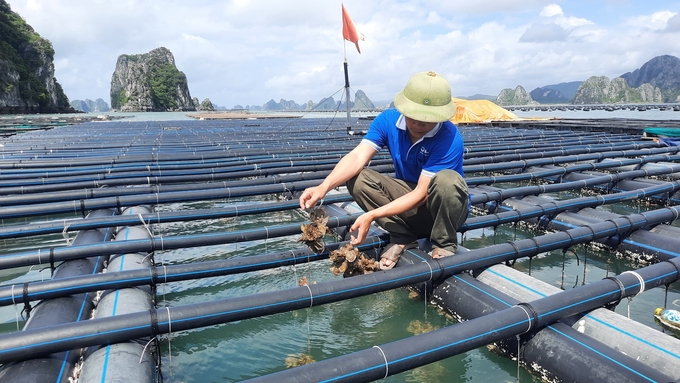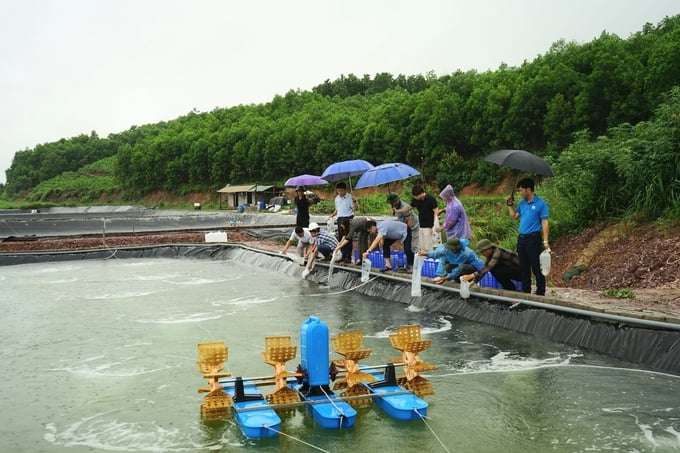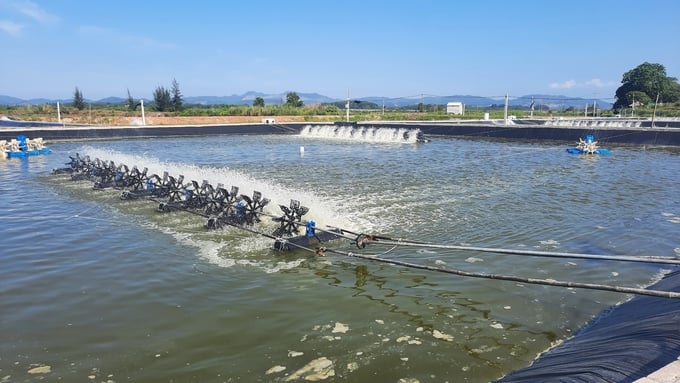November 23, 2025 | 05:18 GMT +7
November 23, 2025 | 05:18 GMT +7
Hotline: 0913.378.918
November 23, 2025 | 05:18 GMT +7
Hotline: 0913.378.918

An employee of Viet Uc Quang Ninh company packing shrimp seeds. Photo: Nguyen Thanh.
The fisheries sector plays a key role in agroproduction activities in Quang Ninh. With a marine farming area of nearly 40,000 ha, Quang Ninh is in high demand for seed, but the local seed supply capacity is still limited.
Quang Ninh Department of Agriculture and Rural Development has conducted inspections and granted certificates of eligibility to produce and nurture aquatic breeds for 16 establishments. Most hatcheries have a system of filter settling tanks, wastewater treatment, storage tanks, broodstock tanks, nursery tanks, etc. The systems are designed, arranged, and operated reasonably which guarantees the seed quality. But up to now the quantity of aquatic seed these hatcheries provide has only partially met the demand in the whole province (shrimp larvae 50% and molluscs only 30%).
The situation forces many businesses and farming households to import seeds from China or neighboring provinces and cities in the Northern region. This not only causes many inadequacies in quality management and seed quarantine but also poses certain risks, making the development of the province's aquaculture industry unsustainable. Also due to the prolonged transportation process and sudden changes in the environment, the quality of stocking seeds is low, difficult to ensure quarantine.

The source of mollusk seed is mainly imported from provinces such as Ninh Binh and Nam Dinh. Photo: Van Nguyen.
It can be said that being proactive in the quantity and quality of seed contributes significantly to the success rate in aquaculture. However, the production of seed sources on the spot is still not commensurate with the province’s existing potential.
Do Dinh Minh, Director of Quang Ninh Sub-Department of Fisheries, said, “We need to soon rearrange and reorganize small, scattered and fragmented seed production establishments, and apply scientific and technical advances to improve production efficiency. The direction is to form centers applying high-tech aquatic seed production and well organize the planning and establishment of concentrated seed production infrastructure.
Currently, for the Vietnamese shrimp industry, the linkage and cooperation between organizations and individuals in the shrimp value chain is still fragmented and ineffective, especially in small scale shrimp farming models. This leads to high production costs, reduced product quality and challenges in traceability.
Le Quoc Thanh, Director of the National Agricultural Extension Center, said: "Regarding the current shrimp farming industry in Vietnam, we have a very good fiscal space. Shrimp farming in a large area shows many positive signs. Many large enterprises have established product value chains, and Vietnamese shrimps have been exported to many countries around the world. However, there are still many small-scale shrimp farming households, and if we farm on a small scale while still applying the same outdated process, it will be difficult to compete in the international market".

Stocking white leg shrimp seed according to the joint production model in Cam Pha city (Quang Ninh). Photo: Nguyen Thanh.
According to Director Thanh, linking small-scale white leg shrimp farming households to form cooperatives will lead to unifying effective shrimp farming methods and good control of diseases especially in the water environment.
"If it is farming on a small scale without linkage, each family would use different types of seed, feed and environment treatment in different ways, thus spreading diseases on farmed shrimp. Therefore, linking small-scale farming households into one large-scale cooperative can solve the problem. We can form a value chain to apply the same process and treat the water environment together, thus overcoming the existing obstacles," said Director Thanh.
A well functioning model has the linkage of five units, including managers, scientists, farmers, suppliers (seeds, feeds, environment treatment products) and product consumption facilities. According to Nguyen Xuan Thang, CEO of Viet Uc Quang Ninh Co., Ltd., this partnership helps farming households stick together along the value chain from seed rearing, processing to exporting.

Small-scale industrial white leg shrimp farming models creating linkage along the value chain will help Quang Ninh shrimp industry develop sustainably. Photo: Van Nguyen.
Viet Uc Quang Ninh Co., Ltd has been building link chains, looking for opportunities and partners to help the development of the shrimp industry. As a seed supplier, the first link in the value chain, Viet Uc Quang Ninh will continue to provide disease-free seeds.
Farmers participating in the link chain model expressed their joy when the previously difficult problem had an answer. Ha Van Hao (Cong Hoa commune, Cam Pha city) said, "My family has been farming shrimp extensively for a long time, but it was not so effective as shrimp often died due to diseases. It is good to have this linkage model now because I am supported in terms of seed, drug, and water testing. I hope that shrimp will have a stable output soon".
Translated by Samuel Pham

(VAN) Results from the Sustainable Durian Model Project in Dak Lak have confirmed the critical role of Yara Viet Nam in transferring advanced nutritional solutions to farmers.

(VAN) In Tuyen Quang province, livestock farmers have introduced effective models and innovative practices that significantly strengthen African Swine Fever prevention and control efforts.

(VAN) This is the study conducted by IRRI and Can Tho University on the rice straw value chain in Mekong Delta showing an economic potential of more than 6.6 trillion VND/year.

(VAN) By participating in cooperative economics, many farmers in Tay Ninh have overcome hardship, mastered clean dragon fruit cultivation techniques.

(VAN) The crossbreeding program in the former Binh Dinh province (now part of Gia Lai) has shown signs of decline, and urgent measures are needed to revive it and sustain past achievements.

(VAN) The agricultural sector agreed on a roadmap to pilot the MRV protocol and expand low-emission rice production from the 2025-2026 winter-spring crop.

(VAN) Agricultural extension officers in Quang Ninh do more than transmit knowledge; they have become a steadfast support system for farmers on the path to sustainable agricultural development.